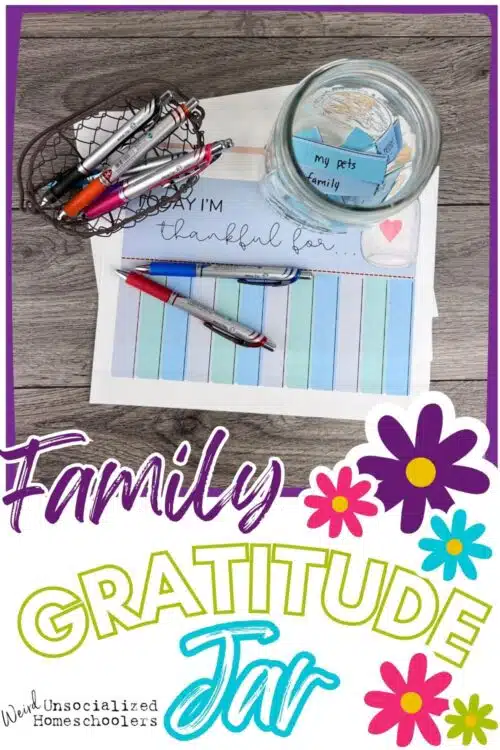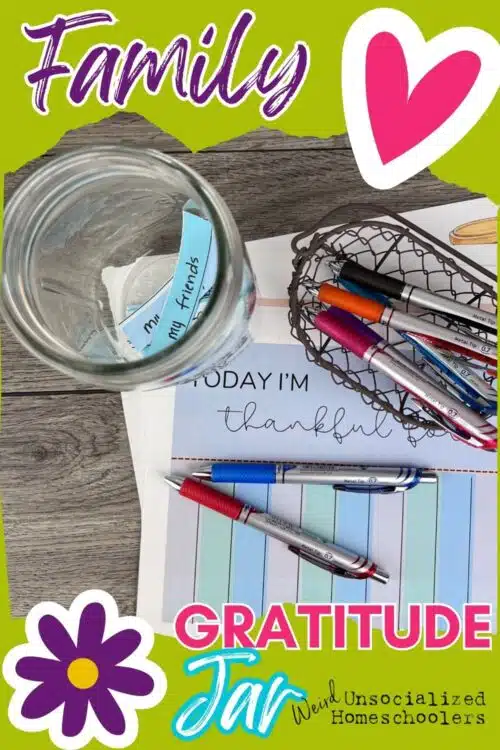Family Gratitude Jars — A Simple Way to Practice Thankfulness This Holiday Season
Fostering a sense of gratitude is a wonderful way to create a more positive atmosphere in our homes – and it’s easy to do with a family gratitude jar!
Family Gratitude Jars — A Simple Way to Practice Thankfulness This Holiday Season
When you practice gratitude, you experience mental, physical, and relational benefits (and your kids do, too!). According to Psychology Today, expressing gratitude on a regular basis is scientifically proven to improve mental and physical health, sleep, relationships, self-esteem, and more.
There are many ways to foster an atmosphere of thankfulness, but one of our favorites is keeping a family gratitude jar. It’s a very simple practice that makes a huge difference in helping you and your family recognize all the good things – large and small – in your lives.
Bonus: it’s a fun homeschool activity during the holiday season!

The Family Gratitude Jar — A Quick Overview
There are many ways to express gratitude. Though we often focus on all that we’re thankful for around the holidays in November and December, we can all benefit from focusing on thankfulness all year long.
Keeping a gratitude jar is a straightforward activity you can do with your whole family at any time of the year. And it’s simple to do. A gratitude jar is essentially a jar that your family fills with small slips of paper detailing the things you’re all thankful for. Easy as {pumpkin!} pie.

Items You’ll Need to Make a Gratitude Jar
A family gratitude jar is such a simple concept that it requires zero special materials. In fact, you probably have everything you need already. Want a list? Here goes!
- a jar (Mason jars work great, but you can use any decently-sized container — try a cup or a bowl too!)
- scissors
- paper cut into strips (roughly 4” long x 2” wide works well)
- pens/pencils/markers
- an envelope or small basket
Yep, that’s it. You can get fancy and decorate the jar if you’d like. Or make “I’m thankful for…” slips to print out instead of plain paper. Or buy pens (or paper) in all the pretty colors. Or stickers to decorate the slips of paper or the jar. But really, the supplies needed are minimal and most households already have items on hand that will work for this activity.
How the Gratitude Jar Works
Like the supplies needed, the “rules” for the gratitude jar are simple. The gist of it is that each day you and your family members each take a slip of paper, write down something you’re thankful for, and stick your paper in the jar.

Then, on Thanksgiving (or any other day of your choosing!), you open up the jar and read the slips of paper to one another.
While you can use the jar any time of year, November is a great time to start. Here’s a step-by-step tutorial of how your family can use this activity all month long to instill a spirit of gratitude in your home.
Step 1:
Choose your container. We like to use a large mason jar, but almost any container will work. If you have younger children, you may not want a breakable jar so try something like an empty, clean peanut butter or mayonnaise jar.
You can leave your jar plain, or decorate it if you’d prefer. Stickers are an easy way to decorate, or you can cut strips of tissue paper or pictures for magazines. Then, use glue or Mod Podge to create a design for your jar.
Step 2:
Pick out your paper. You can use plain white computer paper or get creative. Colored construction paper and scrapbook paper are both fun options. Or buy fall-themed cut-outs at your local craft or dollar store.
Cut your paper into strips. Any size is fine. One easy way to cut your paper strips is to fold your paper in half lengthwise. Cut it in half along the fold. Then, cut eight to ten strips from the two halves.
Step 3:
Store your paper strips in an envelope or small basket near your jar. Each night from November 1st (or whenever you choose to start) through Thanksgiving Day, have each member of your family take a strip of paper and write down one thing they’re grateful for, fold it up, and stick it in the jar.
During your Thanksgiving celebration, break out the jar and have family members take turns reading what everyone is thankful for.
How to Modify the Family Gratitude Jar to Suit Your Family
Of course, you can make adjustments to fit your family. The whole idea of the gratitude jar is to be an easy way to foster an atmosphere of gratefulness in your family so make it work for you.
Try these alternatives:
- Write down what you’re thankful for once per week on Sundays and read them aloud at the end of the month.
- Keep the gratitude jar going all year and read what’s in it on a monthly basis.
- Use the family gratitude jar throughout the entire holiday season and read your thankful slips on New Year’s Eve to ring in the new year.
- I know a mom whose young daughter wrote down things about her mom that she was thankful for. She decorated the jar and gave it to her mom for Christmas. The mom said her daughter is grown up now, but she still has that jar with all those sweet things her daughter said about her tucked inside! You could do the same thing for your parents, grandparents, kids, or even your spouse.
- Make thankfulness a part of your morning homeschool routine by adding your slips of paper each morning and reading them at the end of the week. (This could really help avoid the winter blues!)
- Try a thankful tree for the Thanksgiving season. A thankful turkey is a simple, colorful alternative for families with young children.

The method is less important than the lesson behind the gratitude jar. Fostering a spirit of thankfulness is the key. The gratitude jar is simply a tool.
Unfortunately, it’s easy to take the people in our lives, our possessions, and even daily conveniences for granted. Don’t believe me? Think about the last time your water or electricity wasn’t working. Even if it was only for a few hours, you realize how much you appreciate the convenience of turning on a faucet or flipping a light switch.
Or, how about that ancient mini-van that’s seen its better days? But, it’s paid for and it gets you where you need to go.
I think sometimes it’s even easier for homeschooling families since we’re together all the time. Sometimes we – well, to put it bluntly – get on each other’s nerves. Siblings forget how lonely they are when the other is away from home. Kids (and spouses) don’t think about how much they appreciate mom (or dad) making sure there are hot meals on the table each day.
And, you’ll probably have to wait until they have their own children before yours appreciate the time and financial sacrifices you and your spouse are making to homeschool. (To give you hope – they will eventually. Kris says each of her adult kids has commented on understanding those sacrifices looking back.)

The Takeaway
Gratitude is a principle that, when practiced, is shown to improve your attitude, your life, and your relationships. The holidays are the perfect time to work on expressing thankfulness, but don’t let the habit fade away with the new year. Use this as a jumping-off point to keep encouraging your kids (and yourself!) to recognize the good things happening every day all year through.
What’s your favorite way to practice gratitude during the holiday season? Share it in the comments below!
You Might Also Like:
- 50 Random Acts of Kindness
- Building Strong Family Bonds Within Your Homeschool
- How to Spot a Homeschooler During the Holidays
Amy Thetford is a freelance writer and blogger who homeschools her tribe of tiny humans while pursuing her lifelong dream of becoming a published author. She is fueled by coffee and the desire to do ALL. THE. THINGS. She has the attention span of a squirrel, though she somehow manages to make it through each day with everyone fed and happy (well, mostly happy! Ha!) while striving to make every tomorrow better than the last.







